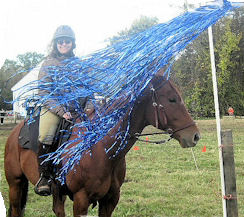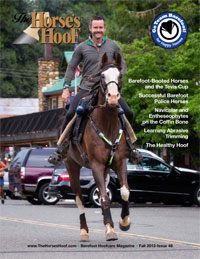
Difference between no clicker and clicker?
No clicker = ‘old school’ Berlitz Language course;
Clicker = Rosetta
The clicker is a TOOL to bridge (no pun intended) and clarify the communications between two species who speak different languages.
More loudly than *anything* to a horse is our intent – our energy – the frequencies we put ‘out there’ in our energy.
Horses don’t have egos and when we go out to a horse with ‘ego’ it puts them on the defense. When horses are defensive they can NOT focus on much else. They seek a safe connection; a safe focus. We don’t have to emulate the alpha mare and who would want to, anyway? Horses don’t like hangin’ out with the alpha mare cause she’s so hyperfocused on her job she’s an unpredictable critter. Lead mares, in the family groups, are much more able to focus on a family member and offer what’s needed at the time.
We aren’t horses. They know that. They’re not stupid. In fact, they’re pretty much just like we are only in fur suits. But because of the physical differences they cannot do certain things that we can and visa versa.
So, back to the clicker — the clicker is a tool that increases the communications exponentially between species (and even within same species ie: little boys and girls and their teachers).
That’s all it is. A highly effective way to TEACH the animal what one is trying to communicate.
BTW — re: submission and learned helplessness and sacking out and such — a good book to read about this is called “Waking the Tiger” by Peter A. Levine. The book explains, clearly, the four F’s … Flight, Fight, Freeze and Faint. Anyone who has seen the results of sacking out when the horse simply stops moving and drops its head after being chased by (insert object of fear here) without anyway to escape? That’s not “Woo Hoo! I get it! I love you now and I’ll do anything for you human!” … that’s a physical and emotional response that puts the horse into ‘Freeze’. There is a physiological response that needs to happen before than animal can mentally work out of that ‘Freeze’. Some animals are extreme and God help the person who is with that horse when it DOES work its way out of the ‘Freeze’ cause it can be pretty ugly.
There’s a helluva lot of trust in the human for a horse to stand with an awake tiger on his back. (or under a ginourmous bird with painfully loud wings rising above. Kudos to you on THAT one, JC! *bravo* !!) And that trust isn’t built in a day from mere mechanics of round penning or sacking out or other anymore than a marriage is made in one –ahem– ‘consumation’.











Well, this was a long time ago, but I will add my two cents in case new folks are reading. Until Gwen sort of talked me into CT, my young colt, Carat, and I were at a standstill. He picked up on CT,(I say an enthusiastic YES), the second time I asked him to touch something he had been afraid of before. HE LOVES his little pieces of apple! Now, he learns something new in only one or two tries. He is very attuned to me and can’t wait to do something right. We ride bareback and with only a halter and lead rope….he has never even seen a bit! Now, I use voice commands almost solely when riding him. If there is a new “monster” outside…..we live in the country with LOTS of big machinery, and once a small forest fire almost made it to his fence……he runs back and forth in front of my kitchen window and neighs until he gets my attention and I either “save him” or go out and get him to touch whatever is scaring him. As long as I am with him, he is not afraid. CT did all of that. And for a person who had never trained a horse, we do pretty well. I have had him since his birth on OUR birthdays. Thanks once again, Gwen, KP
I think that the clicker teaches the human as much as it does the horse.
One has to be spot on with observation and even more spot on with timing. And that goes with good horsemanship all the way ’round anyway. 🙂
I’m not saying its the ‘end all’ — but I’ve found it to be THE most helpful ‘tool’ when working with PTSD horses. I always use the mechanical clicker when starting out and then once the horse understands the ‘process’ of marking a behavior I merely use a unique sound (usually a ‘tongue’ click) … this is because the sound of the actual clicker will make its way in a split second to the amygdala (flight/fight center) of the brain whereas our reactions, our voice — takes more time so there could be 2 or 3 OTHER behaviors or ‘horse thoughts’ that occur in those few seconds it takes to even react for us. So the split second timing (if the human is right on with it) marks THE EXACT INSTANT of what is being requested.
i.e. — someone is trying to teach the horse to lift its hoof for cleaning/exam/care. The horse lifts up its foot then puts it back down and the human says, “Good Boy!” with a pat. What is the ‘Good Boy’ for? For lifting? For putting it down? For the head rub in between? So communications can get pretty muffled at times. OTOH — if one marks the LIFTING of the hoof at the exact instant of the THOUGHT and actual LIFTING then the horse recognizes that ONE behavior that is getting marked (and then the treat adds a motivation to the horse to try again! Like an instant paycheck. Now THAT’D be nice, huh?)
So its a ‘tool’ to use not only for the horse but also to teach the human. If the HUMAN is focused entirely on marking THE INSTANT then there’s nothing else clouding the attention of the human (which, in turn, clouds the communications between the horse and human) … Does that make sense?
So are you saying that all I have learned about communicating effectively with horses over my lifetime that I should just throw out in favor of a .99 cent clicker?
I think clicker training can be effective in the hands of a person who has taken the time to become skilled in it’s use. But honestly I cannot say that I believe it is the be all end all in the bag of tricks!
It’s another tool, a good tool, but a tool none the less! I won’t throw away the round pen or the sacking out tools just yet.
@Tony
I have met many people who have become amazing horsemen/women because they picked up a clicker.
Yes you need to figure out how to get good at training, but isn’t that how you should approach your horse anyway ? Why not figure it out together with your horse ?
The clicker is not a tool per se; it’s just good and educated use of the learning theory that is how every living creature (single cell right through to complex mammals) learns.
Have you seen the horse that clicker training produces ? I’ve never seen any other method produce horses who are so in tune, so good a problem solving, so switched on, and so communicative (to name just a few traits that this brings).
I have clicker trainer friends who have rescued horses that cowboys would not touch and had labelled too dangerous, and these horses are now the horses who teach people to ride.
These people learned to be good horse trainers through throwing out all that they had been taught and picked up a .99c clicker.